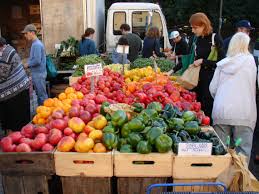The second annual A.T. Kearney survey of U.S. shoppers’ local food buying habits finds that local food is fast becoming a necessity for attracting and retaining grocery customers. Comparing survey results to the 2013 survey, an increased number of shoppers indicate that local foods are an important factor in what they buy and where they buy it. A majority of grocery shoppers in the survey indicated that they think more highly of retailers that carry local food and will consider switching retailers to find better local food selections.
Big box retailers and national grocery chains have work to do on improving their local food selections as consumers rank these outlets lower compared to specialty supermarkets, local supermarkets and farmers markets with regard to their local food offerings.
Findings from the 2014 Local Food Consumer Shopping Survey
Local food remains important for Shoppers. More than 40 percent of respondents say they purchase local food on a weekly basis, and another 28 percent buy local food at least once a month. A majority of respondents say that local food helps the local economy (66 percent) and brings a broader and better assortment of food (60 percent). It is clear that retailers offering local food will positively influence customer perception.
Local food awareness and price perception have improved over the 2013 survey results. Sixty-eight percent of respondents say they are aware that their supermarket of choice offers local food. Similar to 2013, shoppers indicate their primary reason for not buying more local groceries is lack of availability at their retailer of choice. In the 2014 survey 47 percent of respondents say availability is the primary reason they do not buy local, down 10 percent from 2013, which underlines growing awareness of local selections.
Seventy percent of consumers say they will pay a premium for local food. One-third of survey respondents (compared to one-quarter in 2014) say that they will pay a 10 percent premium for local food.
The survey results show that big-box and national retailers still lag in customer perception when it comes to providing high-quality, affordable fresh and local foods. Freshness is a primary factor in grocery shopping decisions and large grocery retailers lag their smaller rivals and farmers markets relative to both price and quality perception when it comes to both “local” and “fresh.”
James Rushing, A.T. Kearney partner and co-author of the study noted, “Given that the research found a strong correlation between fresh and local, large retailers can build awareness of their fresh products simply by sourcing and marketing local products more effectively particularly in categories such as produce, meat, bread, and dairy.”
The local food retail leaders identified in the research have given local managers more autonomy to make local food buying decisions. The local autonomy model optimizes quality, freshness, and availability three critical elements for success in local food identified in the consumer survey.
For a copy of the full report “From Trend to Opportunity: Embracing the Local Food Movement,” go to www.atkearney.com.
Posted by Erica Schmucker
May 10, 2014
